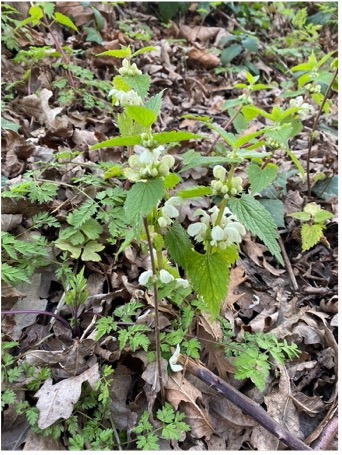Spring is my favourite time of the year, without a doubt. Watching the world come back to life, leaf by leaf, is a truly magical experience. I will never (and I mean never) get tired of seeing new plants emerge from a seemingly dormant earth, and in celebration of that I thought I’d put together a ranking of my top ten spring flowers.
10. White Deadnettle

Despite the misleading name, deadnettle is neither dead nor at all related to the common stinging nettle (helpful, I know). It actually comes from the same family as mint and sage and, like them, is edible and medicinal. Historically, deadnettle has been used to treat heavy or painful periods, but it also has pretty, milky flowers. Red deadnettle is a variant with similar properties to its white companion but with reddish/purple flowers and leaves.
9. Periwinkle

Periwinkle is a ground-covering vine with cheery, purple flowers. It seems to flourish naturally in London and can be seen hanging over walls or crawling across disused garden corners. Although often considered a weed (not that I believe in such libellous terms), the flowers can be used to make a pretty, purple dye – but be careful when handling because it is poisonous if ingested.
8. Grape hyacinth

Not to be confused with hyacinths, grape hyacinths are plants with deep blue, bulbous flowers (that kind of look grapes, if you’re being generous). Although their buds look a little like hyacinth buds, the grape hyacinth is a lot smaller and can more often be found wild than its larger counterpart. The name hyacinth comes from a Greek myth in which the god Apollo accidentally killed his lover, Hyacinthus, with a discus (the ancient equivalent of a frisbee – a very heavy, metal and wickedly sharp frisbee), then turned him into a flower in his grief. The flowers can be crushed to extract a deep purple colour and I’ve made some very successful inks with them!
7. Herb Robert

This hardy little herb grows everywhere and anywhere- I mean it (there’s a very attractive patch of white ones behind the Hastings canteen at the moment). It is found not only in woodland and meadows, but also between paving stones and doorsteps in the suburbs. Medicinally, it has been used for centuries to aid digestion and repel mosquitos. If you couldn’t tell by the shape of the leaves, Herb Robert is a member of the geranium family, and has similar properties to other geranium flowers.
6. Celandines

Historically carried by monks to ward off depression, Celandines are some of the first spring flowers to surface after the colder months. One could be inclined to argue that their cheerful, yellow colour and resistance to the final, harsh frosts of winter make them aptly symbolic for the grit and resilient optimism of our very own Wimbledonian Spirit…
5. Lilac

These graceful flowers are famed for their elegant fragrance. Although lilac is also the name of a light purple colour, the flowers themselves also come in pink, white and deep purple. Lilac is a common cultivated garden plant and is not originally native to Britain, but nowadays it can also sometimes be found growing wild along the edges of woodland.
4. Forget-me-nots

An adorable flower with an equally adorable name, forget-me-nots are a quintessential spring wildflower. Their tiny flowers come in little clusters at the tips of their stalks, and endearingly, you often find a singular pale pink flower in a cluster of blue ones. The Victorians loved forget-me-nots almost as much as I do, and they were used by them as mourning flowers (hence the name).
3. Snowdrops

Though these dainty flowers technically bloom in late winter, for me they herald the start of the return of spring, and thus take spot three on my list. My grandmother has a special fondness for snowdrops (pictured is her garden) and has been known to bid for rare breeds at auctions. Although I’m not quite as much of a snowdrop fanatic as her, it must run in the family because they are a favourite of mine as well.
2. English Bluebells

Classy and classic, bluebells slide easily into spot two. What is it that makes them so nationally loved? Is it the way the stalks curve down and darken towards the tip to allow the flowers to hang like bells? Their striking deep blue? The delicate curling of the tips of their petals? Regardless, bluebells are widely recognised as Gorgeous. Although the (invasive) Spanish bluebell gets bonus points for colour variety, the iconic English bluebell will always have my heart when push comes to shove. I’ve also spotted both English and Spanish bluebells growing around school- do look out for them and see if you can tell them apart!
1. Wood Anemones

Usually the precursor to bluebells in British forests, Wood Anemones are, without a doubt, my favourite spring flower. While their plain white flowers may be considered boring to some, what makes these flowers really magical is the way they completely cover an area, turning normal woodland debris into a carpet of green and white. Although ‘Bluebell woods’ are revered for doing something similar, I would argue that Anemones are even more impressive as they flood the woodland fully and totally, leaving not a patch of dirt uncovered. Either way, woodlands where Anemones thrive are likely to be the same woodlands where Bluebells will thrive a month or so later, so if you come across either of these, you’ve hit the spring flower jackpot.
Sources: all photos are my own and all information from my own knowledge and experience
